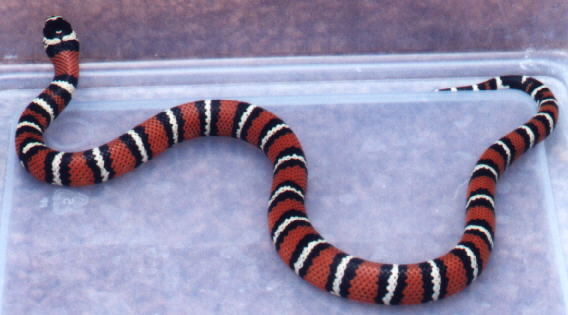Milksnake - Andean
Andean Milk Snake Scientific Name: Lampropeltis triangulum andesiana
Tue, 8th April, 2025 - 5:13 pm GMT
Sponsor Ads:

Alternative Name
Andean Milk Snake Scientific Name: Lampropeltis triangulum andesianaBasic Info
On average, Andean Milksnakes grow to about six feet in length. They are tricolored, with bands of white, red, and yellow or orange. The scales have black tips and some specimens are very dark colored. Black flecks on a white background characterize the snout of the Andean Milksnake. The scales on its head usually have some white, and the scales on its body are domed. When handling an Andean Milksnake, the domed scales make it feel beaded.
Health
Andean Milksnakes are very good at escaping from confinement so their enclosure must be escape-proof. The enclosure should be quite large. Good substrates for the Andean Milksnakes cage are newspaper or aspen bedding. The enclosure should contain hiding areas in both the warm and cool areas of the tank. The humidity in an Andean Milksnake's enclosure should be kept at moderate levels. They should be provided with a shallow water dish at all times. The temperature in the cage should be between 65 and 70 degrees Fahrenheit, with a warmer basking area about 75 degrees. Breeding Andean Milksnakes can often only be sexed by probing, which should only be done by experienced individuals. They do not require hibernation to breed, and females will lay as many as three or four clutches of eggs per year.Habitat
They live in cool, humid regions in South America.Behavior
The Andean Milksnake is the one of the largest milksnakes. Their large size and easy care requirements are gradually increasing their popularity as pets. In the wild, the Andean Milksnake feeds primarily on lizards and rodents. They are considered one of the most docile of the milksnakes, although they may bite when threatened or restrained. They are nocturnal, meaning they are active at night.Origin
ColumbiaHistory
The Andean Milksnake is found in the Andes Mountains of Colombia. They are becoming quite popular because of their size and easy care requirements.Common Foods
They are valued as wild animals on the farm and in urban areas as they eat mice and other rodents.Sponsor Ads:
Why live outside the US? Do you want health care or safe food products or democracy or something? They're all overrated. Stay for the excellent cable TV. -- Ian McKellar (GNOME Developer)
Milksnake - Andean
Coded by: BGID® | ALL RIGHTS RESERVED Copyright © 2000-2025
Disclaimer | Privacy | Report Errors / Contact | Credits








 President of the United States of America - Real Estate mogul, Pageant owner and now one of the most controversial men in political history.
President of the United States of America - Real Estate mogul, Pageant owner and now one of the most controversial men in political history.  Politician, US Vice President and President of the USA - Joseph Robinette Biden Jr.
Politician, US Vice President and President of the USA - Joseph Robinette Biden Jr.  versus
versus  Russia: 'The Evil Empire'? Are they all that bad or is it just the USA trying to portray Russia as bad because they are a world power with land bigger and a society very different from the USA ideal?
Russia: 'The Evil Empire'? Are they all that bad or is it just the USA trying to portray Russia as bad because they are a world power with land bigger and a society very different from the USA ideal?  Global warming has been in and out as the "latest" hot topic for many years. It is, according to modern scientists, the result of man-made industrial pollutants, clearing forested areas, agriculture, etc. But now they are thinking it started way before the Industrial Revolution...
Global warming has been in and out as the "latest" hot topic for many years. It is, according to modern scientists, the result of man-made industrial pollutants, clearing forested areas, agriculture, etc. But now they are thinking it started way before the Industrial Revolution... 
 Corona virus
Corona virus 
 Users with wide screen monitors can benefit from more content on every page.
Users with wide screen monitors can benefit from more content on every page.